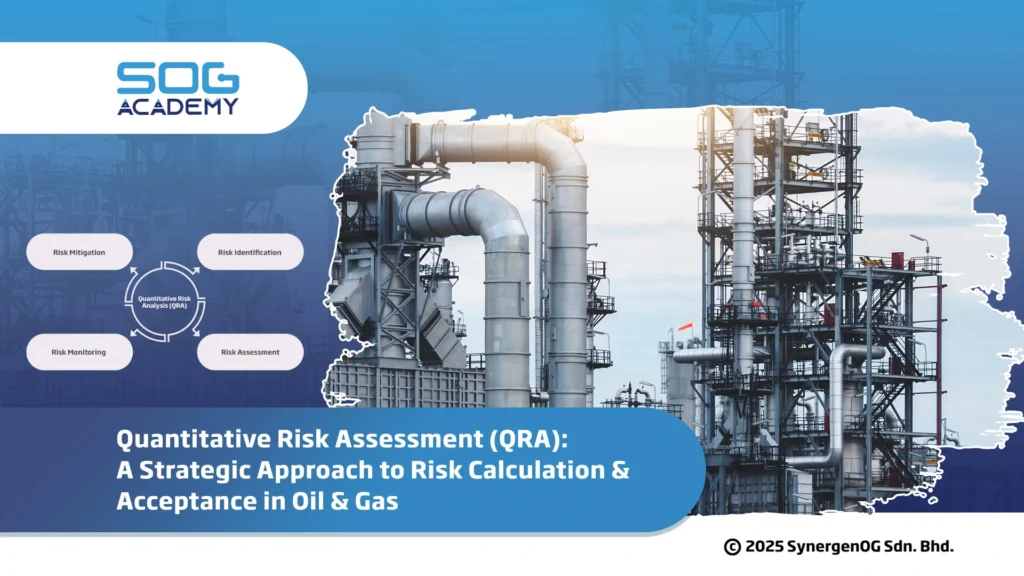In high-hazard industries like oil and gas, managing risk is not just a compliance requirement; it’s a fundamental part of ensuring operational integrity, protecting lives, and safeguarding assets. Quantitative Risk Assessment (QRA) provides the structured methodology necessary to evaluate, quantify, and manage these risks effectively.
At SOG Academy, we train professionals to approach QRA not as a theoretical exercise, but as a practical, data-driven decision-making tool embedded in day-to-day operations. Here’s a structured overview of how QRA is applied in the real world, from hazard identification to stakeholder communication.
RISK IDENTIFICATION & MODELING
1. Hazard Identification
A sound QRA begins with a thorough hazard identification (HAZID) process. This involves identifying and characterizing potential hazards related to equipment failures, human errors, and external threats. Recognizing these hazards early ensures that the assessment remains relevant and aligned with actual operational exposures.
2. Data Collection
Accurate data forms the backbone of QRA. Teams must gather detailed information on equipment design, operating parameters, historical incidents, and failure rates. This phase directly influences the reliability of event frequency and consequence models later in the process.
3. Selecting the Right Risk Models
QRA leverages established risk modeling techniques such as:
- Fault Tree Analysis (FTA)
- Event Tree Analysis (ETA)
- Consequence Modelling
Selecting the appropriate model depends on the system complexity and the types of hazards being assessed.
4. Estimating Event Frequency
A key element of QRA is determining the probability of occurrence. Initiating events and contributing factors must be analyzed to develop realistic frequency estimates for various scenarios.
5. Conducting Consequence Analysis
This stage assesses the impact of identified scenarios on people, the environment, and assets. Outputs often include:
- Fatality estimates
- Damage extent
- Environmental Impact Projections such as dispersion modeling of toxic or inflammable releases
Consequence analysis provides the quantitative foundation for evaluating risk severity.
QUANTIFICATION & EVALUATION
6. Risk Calculation and Classification
Risk is typically calculated as:
Risk = Likelihood × Consequence
These calculations result in individual and societal risk values. These are often visualized using FN-curves or risk matrices to support decision-making. (Note: FN-Curves typically used in societal risk assessments; help visualize cumulative risk across scenarios involving multiple fatalities.)
7. Risk Tolerance and Acceptance Criteria
Before evaluating calculated risks, companies must define their risk tolerance thresholds, often guided by:
- Regulatory frameworks
- Industry best practices (e.g. ALARP)
- Company-specific tolerability limits
Clear acceptance criteria ensure consistency and transparency in evaluation.
8. Risk Evaluation and Benchmarking
Calculated risks are compared against the established thresholds. Where risks exceed tolerable levels, this triggers the next phase – mitigation planning.
9. Risk Mitigation Strategies
Mitigation may involve:
- Engineering barriers (e.g., isolation valves, fire suppression)
- Administrative controls
- Process improvements
Actions are prioritized based on effectiveness and feasibility.
10. Cost-Benefit Analysis (CBA)
In alignment with ALARP principles, cost-benefit analysis is applied primarily to risks that fall within the tolerable range, to determine if further reduction is reasonably practicable. This involves comparing the cost of risk reduction versus the benefit gained in risk reduction.
RISK ACCEPTANCE & ASSURANCE
11. Acceptance or Further Reduction?
At this stage, the organization must decide whether to accept the residual risk or pursue further reduction. The decision-making process should be evidence-based and aligned with organizational risk appetite.
12. Documentation and Traceability
A complete QRA process includes well-documented models, assumptions, data sources, and decisions. This supports both internal governance and external regulatory compliance.
13. Continuous Monitoring
Risk is not static. Changes in operations, technology, or human behavior must trigger QRA reviews. A robust monitoring framework helps maintain an up-to-date understanding of operational risks.
14. Leadership Involvement
Senior management must lead by example, actively engaging in QRA reviews and promoting a culture where safety is a shared responsibility.
15. Communication and Engagement
Transparent communication of QRA findings – internally and externally – strengthens credibility and stakeholder trust. This is particularly vital when engaging with regulatory bodies and local communities.
16. Audit and Verification
Routine audits are necessary to validate the accuracy of risk models and the effectiveness of implemented safeguards. Verification ensures that assumptions remain valid over time.
17. Emergency Response Alignment
QRA findings should directly inform emergency response planning. Scenarios modeled during risk assessments help organizations develop realistic and effective contingency measures.
18. Regulatory Compliance
Lastly, QRA must be aligned with regional and international process safety regulations. Compliance with standards such as OSHA PSM, UK HSE, and ISO 31000 is essential for project approvals and ongoing operations.
Train with SOG Academy
If you’re a professional or organization looking to elevate your risk management capability, SOG Academy’s Quantitative Risk Assessment Training is designed to deliver actionable knowledge grounded in industry practice. Our course combines theoretical rigor with real-world application, ensuring your team is ready to make informed, defensible decisions in high-risk environments.

